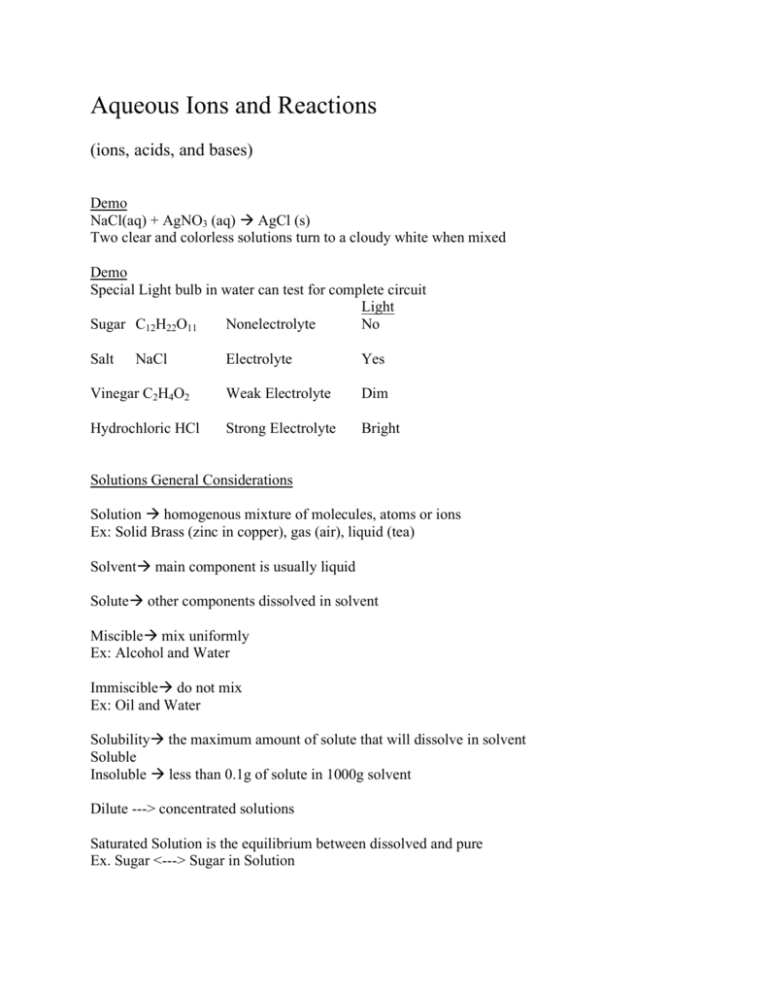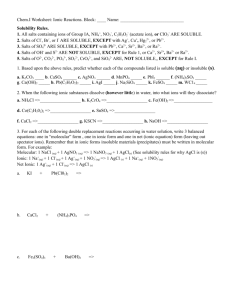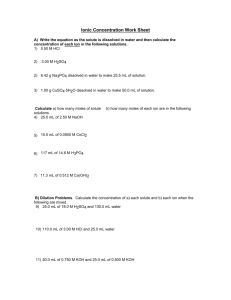Aqueous Ions and Reactions
advertisement

Aqueous Ions and Reactions (ions, acids, and bases) Demo NaCl(aq) + AgNO3 (aq) AgCl (s) Two clear and colorless solutions turn to a cloudy white when mixed Demo Special Light bulb in water can test for complete circuit Light Sugar C12H22O11 Nonelectrolyte No Salt NaCl Electrolyte Yes Vinegar C2H4O2 Weak Electrolyte Dim Hydrochloric HCl Strong Electrolyte Bright Solutions General Considerations Solution homogenous mixture of molecules, atoms or ions Ex: Solid Brass (zinc in copper), gas (air), liquid (tea) Solvent main component is usually liquid Solute other components dissolved in solvent Miscible mix uniformly Ex: Alcohol and Water Immiscible do not mix Ex: Oil and Water Solubility the maximum amount of solute that will dissolve in solvent Soluble Insoluble less than 0.1g of solute in 1000g solvent Dilute ---> concentrated solutions Saturated Solution is the equilibrium between dissolved and pure Ex. Sugar <---> Sugar in Solution Unsaturated lower concentration than saturated Supersaturated more concentrated (not stable) Solutes may be: Electrolytes (ions) conduct electricity Nonelectrolytes (molecules) do not conduct Demo demonstrates these properties Ex: NaOH HCl NaCl Glucose (sugar) Sucrose Na+ OHH+ ClNa+ ClC6H12O6 C12H22O11 Ions or molecules in solution are hydrated (surrounded with water molecules) (http://www.emc.maricopa.edu/faculty/farabee/BIOBK/BioBookCHEM2.html) Strong Electrolytes dissociate completely (100%) Weak Electrolytes partially dissociate Ex. of Weak Electrolyte CH3COOH <----- --> C2H3O2- + H+ (Acetic Acid) Percent Dissociation = 1% Equilibrium lies to the left Ex. of Strong Electrolyte HCl H+ + ClPercent Dissociation = 100% Shift to the right completely Other Strong Electrolytes that need to be MEMORIZED HCl, HBr, HI, HNO3, H2SO4, HClO4 Ionic Reactions Molecular: NaCl (aq) + AgNO3 (aq) AgCl (s) + NaNO3 (aq) Complete Ionic: Na+ + Cl- + Ag+ + NO3- AgCl (s) + Na+ + NO3Net Ionic: Ag+ (aq) + Cl- (aq) AgCl (s) (precipitate) In a Net Ionic the spectator ions are left out Think in terms of ions in solution and not just formulas as written Na+ (aq) means aqueous or in water If aq not given Na+ can still assume in water solution if discussing solutions but for something like NaCl must specify NaCl(s) or NaCl(aq) Metathesis double displacement Two compounds in solution and exchange of cations Actual change: NaCl + AgNO3 AgCl + NaNO3 Net Ionic Reaction: Ag+ (aq) + Cl- (aq) AgCl (s) OR no real change KCl + NaNO3 KNO3 + NaCl No Reaction just ions in solution K+ Cl- Na+ NO3Reaction will occur if: 1. Precipitate formed 2. Weak electrolyte formed 3. Gas formed These will have the effect if remove product the equilibrium shifts to the right and more product is formed (LeChatlier’s Principle) Solubility Rules (Don’t have to learn for my course but know how to use this information) Salts always soluble: alkali metal, NH4+, NO3-, ClO3-, ClO4-, C2H3O2- Salts soluble with exception: Cl-, Br-, ISO42- except Ag+, Pb2+, Hg22+ except Ca2+, Sr2+, Ba2+, Pb2+ Salts insoluble: metal oxides and hydroxides except Ca2+, Sr2+, Ba2+, alkali (give base) CO32-, PO43-, S2-, SO32except NH4+, alkali metal Solubility and Precipitation Reactions Reaction Occur if: 1. Precipitate Formed Soluble (dissolve > 10g/L) Partially Soluble Insoluble (dissolve < 1g/L) NaCl PbCl2 AgCl NaCl Na+ + Cl- (lot) PbCl2 <--- --> Pb2+ + 2Cl- (little) AgCl <---- -> Ag+ + Cl- (very little) Soluble will have no precipitate Precipitate will form in partially soluble or insoluble if ions > 0.1M In next course can assign numerical values but this is just qualitative Not expected to memorize the solubility rules But be able to use and know ion charges Example: Given: Ca(OH)2 soluble and Mg(OH)2 insoluble Ocean Water contains 0.13% by weight Mg How could you separate Mg from ocean water? Ca(OH)2 + sea water (Mg2+) Ca2+ + Mg(OH)2 (s) Ca(OH)2 (aq) Ca2+ + 2OHMg2+ + 2OH- Mg(OH)2 (s) Net Reaction In Freeport Texas there is a large plant that to produce magnesium from ocean water Naming Oxoacids In problems look up if precipitate forms On the exam it will tell you if insoluble or precipitate, otherwise assume soluble NaCl + NH4NO3 No Reaction THINK IONS 2. Weak Electrolyte Formed HC2H3O2 (aq) <---- --> H+ (aq) + C2H3O2- (aq) 99% acetic acid 1% acetate ion If produce acetate it will quickly attract H+ HCl (aq) + NaC2H3O2 (aq) Na+ + Cl- = NO H+ + C2H3O2- = YES Net Ionic: H+ + C2H3O2- HC2H3O2 Spectator: Na+ and ClIf it forms water then it is a weak electrolyte Fe2O3 (s) + 6H+ (aq) 2Fe3+ (aq) + 3H2O Metal oxide is soluble in acid and not in water (pure) 3. Gas Formed KNOW (there are others): CO2 SO2 NH3 H2S H2 carbon dioxide sulfur dioxide ammonia hydrogen sulfide hydrogen Gas Directly 2HCl (aq) + Na2S (aq) 2H+ + 2Cl- 2Na+ + S2- H2S (g) + 2NaCl (aq) Gas Indirectly Vinegar and baking soda (mix in medicine bottle, shake and throw in air) H+, C2H3O2-, NaHCO3 (sodium bicarbonate) H+ Na+ HCO3- H2CO3 (aq) Na+ C2H3O2- <----> CO2 (g) + H2O The carbonic acid decomposes ? if acetic acid was only 1% would there be enough? This would drive the reaction to the right and pull H+ off vinegar Alka Seltzer, citric acid and sodium bicarbonate fizz in water Cases in medical literature where eating baking soda the gas blows the stomach apart Naming Acids Naming Binary Acids hydro___ic acid (nonmetal root) Binary Acids Table HCl H2S HF Compound Name hydrogen chloride hydrogen sulfide hydrogen fluoride Aqueous Solution hydrochloric acid hydrosulfuric acid hydrofluoric acid use _____ic acid OR ____ous acid If root name is ate-->ic ite-->ous Oxoacids Table Compound Name Aqueous Solution H2SO4 H2SO3 HNO3 HNO2 If prefix then continue to use Example: Perchloric acid HClO4 Hypochlorous acid HClO hydrogen sulfate hydrogen sulfite hydrogen nitrate hydrogen nitrite sulfuric acid sulfurous acid nitric acid nitrous acid Naming Acid Salts Use bi in place of hydrogen H2SO4 hydrogen sulfate = bisulfate (Ion: SO42- sulfate) NaHCO3 sodium bicarbonate (baking soda) (Ions: Na+ HCO3-) Several Hydrogens then indicate H3PO4 -----> phosphoric acid H2PO4- -----> dihydrogen phosphate HPO42- -----> hydrogen phosphate PO43- -----> phosphate Acid and Bases in Aqueous Solutions Application observe in lab: acid turns litmus red Base turns litmus blue Acid-Base Concepts Arrhenius Bronsted-Lowry LewisSolvent System Common Strong Acids HCl HBr HI HNO3 H2SO4 HClO4 Common Strong Bases Acid Substance produce H+ (H3O+ Hydronium) in water Donate Proton Accept electron pair Give solvent cation NH4+ Base Produce OH- (Hydroxide) in water Accept Proton Donate electron pair Give solvent anion NH2- in liquid ammonia NaOH KOH Ca(OH)2 Ba(OH)2 Arrhenius Acids and Bases Acid increase concentration of hydronium ion (H3O+) Base increase concentration of hydroxide (OH-) Acid: HCl (aq) + H2O H3O+ (aq) + ClHCl (aq) H+ (aq) + Cl- (aq) Base: Ca(OH)2 (s) Ca2+ (aq) + 2OH- (aq) NH3 (aq) + H2O NH4+ (aq) + OH(acid) Often: Acid + Base Water + Salt HCl + NaOH H2O + NaCl (aq) Note: it stays as ions Na+ and ClBronsted-Lowry Acids and Bases Acid is a substance that can donate a proton Base is a substance that can accept a proton Reaction involves the transfer of protons from acid to base Acid 1 + Base 2 <-----> Acid 2 + Base 1 HC2H3O2 + H2O <----> H3O+ + C2H3O2Conjugate Acid-Base pair HC2H3O2 and C2H3O2-, H2O and H3O+ Equilibrium lies more to left so H3O+ is a stronger acid than acetic acid Water can act as an acid or base Acid 1 Base 2 H2O + NH3 <--- --> Acid 2 NH4+ NH4 is a stronger acid than H2O OH- is a stronger base than NH3 When an acid gives up a proton it forms a base When base accepts proton it forms an acid HA + H2O <----> H3O+ + Aacid base acid base HA and A- are conjugate acid-base pair Base 1 OH- H3O+ and H2O are conjugate acid-base pair Monoprotic: means donate one proton (ex. HCl and HC2H3O2) Polyprotic Acids: can donate more than one proton Examples: H2SO4 hydrogen sulfate is diprotic (sulfuric acid) H3PO4 hydrogen phosphate is triprotic (phosphoric acid) H2SO4 + H2O H3O+ + HSO4HSO4- + H2O <----> H3O+ + SO42Acid 1 Base 2 Acid 2 Base1 Amphiprotic: ion or molecule that can accept or donate a proton In the example above HSO4- is amphiprotic Types of Reactions Chemical reaction – atoms are rearranged (may or may not be obvious by simple observation) Traditional Scheme: Combination 2Na (s) + Cl2 (g) 2NaCl (s) Decomposition 2KClO3 (s) (heat and MnO2 catalyst) 2KCl (s) + 3O2(g) Displacement Zn (s) + CuCl2 (aq) Cu + ZnCl2 (aq) Zn (s) + 2HCl (aq) H2 (aq) + ZnCl2 (aq) Metathesis AgNO3 (aq) + NaCl (aq) NaNO3 (aq) + AgCl (s) (Double Displacement) Combustion 4 Fe (s) + 3O2 (g) 2FeO3 (s) C (s) + O2 (g) CO2(g) Other Schemes: Redox and Other (such as acid-base) Reaction in Solution Acid + Base Salt + Water Conc. 0.15M 0.75M H2SO4 (aq) + 2NaOH (aq) Na2SO4 (aq) + 2H2O Sulfuric Acid Sodium Hydroxide Sodium Sulfate Water How many ml of NaOH to react completely with 50 ml of H2SO4? ?mL NaOH = (0.050L H2SO4)(0.15 mol H2SO4 / L)(2 mol NaOH/ 1 mol H2SO4)(1L/0.75 mol NaOH) = 0.020 L = 20 ml H2SO4 = 0.0075 mol 50 ml 0.15M 7.5 x 10-3 NaOH = 0.0150 mol 25 ml 0.75M 1.5 x 10-3 Note: that this gives the needed 1:2 ratio Need twice as much NaOH Summary: vol A –(conc)--> mol A –(Balanced Eq.)--> mol B –(conc-1)--> vol B Example: How many grams BaSO4 formed? Ba2+ (aq) + SO42- (aq) BaSO4 (s) First you have to find how many moles formed? 20.0 ml of 0.150M Al2(SO4)3 (3(SO4)/ 1 Al2(SO4)3)(20 x 10-3 L)(0.150 mol Al2(SO4)3/ L) = 9.00 x 10-3 mol SO4230.0 ml of 0.200M BaCl2 (1 Ba/ 1 BaCl2)(30 x 10-3 L)(0.200 mol BaCl2/L) = 6.00 x 10-3 mol Ba2+ Ba2+ and SO42- combine 1:1 so excess of SO42- which mean Ba2+ limiting reactant 6.00 x 10-3 mol BaSO4 (233.4g BaSO4/ 1mol BaSO4) = 1.40g List ions and possible combination (any insoluble? See rules) Cations Anions Al3+ and SO42- is soluble Ba2+ and Cl- is soluble Al3+ and Cl- is soluble Ba2+ and SO42- is insoluble Stoichiometry of Ionic Reactions Various ways of expressing concentration For example Weight percent of sulfuric acid 96% (w/w) H2SO4 or 96% H2SO4 Means 96% H2SO4 and 4g of H2O in 100g of total acid solution But for most uses molarity M ( mol solute/ liter solution) will be used Know how many ions in solution 0.2M CaCl2 (aq) 0.2M Ca2+(aq) and 0.4M Cl-(aq) since CaCl2 Ca2+ + 2ClStoichiometry is just like earlier calculations Remember: (g) gas (s) solid (l) liquid (aq) aqueous in solution Oxidation Numbers and Redox Reactions (covered in “Redox” material)






